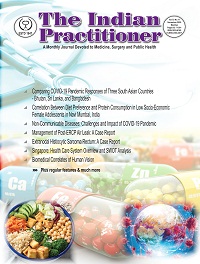Correlation Between Diet Preference and Protein Consumption in Low Socio-Economic Female Adolescents in Navi Mumbai, India
Abstract
Objective: Studies have shown the prevalence of Protein Energy Malnutrition (PEM) in adolescents among low socio-economic group. Thus, this study was carried out to understand link between protein intake and diet preference across Body Mass Index (BMI) categories in female adolescents belonging to low socio-economic group.
Method: 486 female adolescents between age group 10-17 years were randomly selected. Of which, 123, 48 and 315 preferred vegetarians, eggetarian and non-vegetarian respectively. The school faculties and parents of the children were prior consented for the data collection of the observatory study. The 3 categories of BMI were considered- Underweight/ Poor weight, Healthy weight and Overweight/Obese. Height, Weight, Diet preference and 7-day food recall was recorded
for each of them. Consumed protein intake was then calculated using Ntuitive software which was then compared with Recommended Dietary Allowance (RDA). Statistical analysis was conducted using IBM SPSS version 20 to evaluate association between protein intake and dietary preference across BMI.
Results: Statistical analysis showed that protein consumption in non-vegetarians was found to be significantly correlated (p=0.006) across all BMI categories. However, there was no association found in vegetarians and eggetarians with respect to protein consumption and BMI (p=>0.05). 60.7% were found to be deficit in protein consumption among non-vegetarians which may be due to their low socio-economic status and affordability.
Conclusion: The socio-economic factors that significantly influenced protein consumption among them can be the parent’s income status and family’s affordability, number of siblings in the family, lack of knowledge and awareness in family, preparation or method/ way of cooking techniques. The diet preferences did influence the protein intake in low socioeconomic
Source of Support: Nil
Conflict of Interest: There are no conflicts of interest.
References
2. Spear BA. Adolescent growth and development. Journal of the Academy of Nutrition and Dietetics. 2002 Mar 1:S23.
3. Khan MR, Ahmed F. Physical status, nutrient intake and dietary pattern of adolescent female factory workers in urban Bangladesh. Asia Pacific journal of clinical nutrition. 2005 Mar 1;14(1):19.
4. Chaturvedi S, Kapil U, Gnanasekaran N, Sachdev HP, Pandey RM, Bhanti T. Nutrient intake amongst adolescent girls belonging to poor socioeconomic group of rural area of Rajasthan. Indian pediatrics. 1996 Mar 1;33:197-202.
5. Sakurai M, Nakagawa H, Kadota A, Yoshita K, Nakamura Y, Okuda N, Nishi N, Miyamoto Y, Arima H, Ohkubo T, Okamura T. Macronutrient intake and socioeconomic status: NIPPON DATA2010. Journal of epidemiology. 2018 Mar 5;28(Supplement_III):S17-22.
6. Kapil U, Manocha S, Bhasin S. Dietary intake amongstwell to do’adolescent boys and girls in Delhi. Indian pediatrics. 1993 Aug;30:1015.
7. Khadilkar V, Yadav S, Agrawal KK, Tamboli S, Banerjee M, Cherian A, Goyal JP, Khadilkar A, Kumaravel V, Mohan V, Narayanappa D. Revised IAP growth charts for height, weight and body mass index for 5-to 18-year-old Indian children. Indian pediatrics. 2015 Jan 1;52(1):47-55.
8. Longvah T, Ananthan R, Bhaskar K, Venkaiah K. Indian Food Composition Tables 2017. National Institute of Nutrition. 2017 [Accessed on 29 October, 2019].
9. USDA Food Composition Table. 2019. Available from: https://fdc.nal.usda.gov/
10. Yetubie M, Haidar J, Kassa H, Fallon F. Socioeconomic and demographic factors affecting body mass index of adolescents students aged 10–19 in Ambo (a rural town) in Ethiopia. International Journal of Biomedical Science: IJBS. 2010 Dec;6(4):321.
11. Bhutia DT. Protein energy malnutrition in India: the plight of our under five children. Journal of Family Medicine and Primary Care. 2014 Jan;3(1):63.


